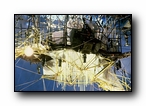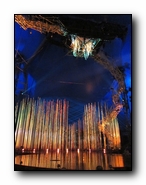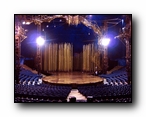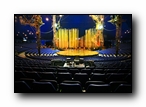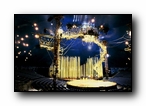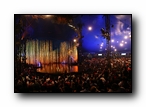
![]()
[ You are here: Grand Chapiteau | Creations | Varekai | Scénographie ]
Création
Expérience
RéserveRetiré
Odyssey
Stéphane Roy set out to create a contextualized set for Varekai — a design in which all the elements harmonize with the poetry and language of performance: costumes, scenery, and music. "In circus, design is essentially the choice of the spatial context that the director, the other creators and the artists must inhabit. Whether abstract or realistic, it serves to create a mood." His target with Varekai was to create a place where magical things could happen. "It was a clearing inside a forest where people could get together," he says. "A place of refuge, a place of context." Using Discreet's 3ds Max animation software and Pro/E (industrial engineering software), Roy and his staff of 12 developed the initial concepts of a forest set that would both enchant the audience and allow the Cirque performers to safely execute their moves. And what a fabulous and mysterious hideaway the VAREKAI characters have made their home in...
Sound design for Varekai was the work of 14-year Cirque veteran Francois Bergeron. But unlike some of his previous efforts, where sound design was largely an after-the- fact process, with Varekai Bergeron was on the creative team from the early conceptual stages. "Because I was involved with the show from the beginning, I was able to fully integrate the audio elements into the overall concept and into the set," he says. And that’s a good thing, because according to Bergeron, Varekai features the most complex audio of any Cirque show he's worked on thus far. "The sound basically reinforces the set design, with the power emanating from the center above the stage. I think this is definitely one of the best-sounding Cirque tours yet, and that's in part because I was able to position the Meyer speakers to maximum advantage." Daniel Petit, who is in charge of all audio for Cirque du Soleil, was also instrumental in piecing together Varekai's sound system. Also involved in the audio component was Varekai director Dominic Champagne. “He loves the audio world, and as a result, we were able to integrate the systems into the set and help the creative aspect of the show,” says Bergeron. The result is a wall-to-wall audio experience, featuring “audio surprises” that far surpass “mere” music and sound effects. “Because I was playing DJ in the rehearsal, throughout the rehearsal process I played all sorts of music, sound effects, bits, and samples to stimulate the actors and acrobats into responding to ambience and feeling,” says Bergeron. “It wasn't just playing a CD. From there, the composer, Violaine Corradi, was inspired by what was happening on stage and the reaction of the acrobats to the environment.” All the action takes place inside the portable 50-meter (165-foot) long tent with a seating capacity of over 2,600, and this poses quite a unique challenge. According to Bergeron, the tent's flexible PVC skin, when stretched taut, presents a surprisingly hard acoustical surface and is highly reflective at problematic frequencies. "It's really quite reverberant, especially when empty," he says. "For example, at 1 kHz we measured a reverb time of about 5.4 seconds. So you have to be careful with your coverage and alignment of speakers." In an unusual tactic, Bergeron created an inverted sound design, using AutoCAD design software to make his calculations. “This time, rather than fighting the space and fighting the canvas, I decided to try to use it,” he explains. “As a result, I concentrated the sound system from the top, above the ring. Instead of having the sound system on the ground and using the ground to increase the low end and the sub bass, here the sub bass is above, which in sound is a kind of no-no. You don't have any surface to bounce on and increase the level of the low end. But, because we were so close to the center of the tent, the canvas is so tight that it functions as a floor, and we used it to that effect.” Inverting the sound design for Varekai was a first for a Cirque du Soleil show, and Bergeron relied on self-powered speakers from Meyer Sound Laboratories, Berkeley, Calif., to achieve the desired result. “One of the benefits with Meyer is that they do their measurements in an anechoic chamber, which makes their manufacturer specs very accurate,” says Bergeron. “With the MAPP [testing] software, you can do a lot of predicting. Based on that, we could easily put the speakers in the set, and know what we were going to get.” Other parameters included the fact that with no backstage area, the sound system had to be integrated into the set. “There's not much leeway,” says Bergeron. “The selection of the speakers came down mostly to size, power, weight, and of course, budget.” Weight was a crucial factor, since the speakers would be mounted on the tent structure itself, which was also supporting acrobatic rigging and lighting. “There's no wasted real estate,” adds Bergeron. “It's literally wall-to-wall.” To supply the needed power from above the stage while avoiding destructive reflections, Bergeron devised a system comprising three center clusters and an outer delay ring. The two outside clusters, each with a pair of CQ-1 Wide Coverage Main loudspeakers, flank the middle cluster of three CQ-2 Narrow Coverage Main loudspeakers. While these clusters anchor the sound high above the stage, supplemental reinforcement is supplied by the delay ring of ten UPA-1P Compact Wide Coverage loudspeakers. Deep bass power, which for both logistical and artistic reasons also had to come from above, is provided by four PSW-2 High-Power Flyable subwoofers that are hoisted up in the cupola.All of the speakers are camouflaged within groupings of the set's pipes. "We chose the Meyer line of speakers for this show first because of the precise control," comments Bergeron, "but also because we have been touring for years with Meyer self-powered speakers and they are very reliable. Having the amplifiers inside the box eliminates many of the places where things can go wrong in the audio chain." Constantly changing temperature and humidity in the big top was another factor the audio team had to contend with. When the show starts, the doors are opened on an empty space. Once the tent is filled to capacity, the doors are closed and the temperature and humidity change significantly.To solve the problem, Pitsch Karrer, who heads the show's sound department and serves as mixer on Varekai, uses a temperature probe and hydrometer (humidity gauge) to take a reading of the elements he's dealing with. And, says Bergeron, Cirque du Soleil has also made strides in improving temperature control with an HVAC system in the tent. “We're in the process of cataloguing changes in relationship to temperature and humidity,” he says. “We'll be able to predict, with a table, before the show what changes need to be made. Each of those parameters will be stored in the computer, and we'll be able to recall them at the drop of a hat.” Bergeron states that the tight confines of the tent were also a point in favor of the powered systems. "We save space with them. We literally did not have any backstage space in this show for amplifier racks." The demands of Varekai quickly put the system to a grueling test. "This is definitely one of the most audio-oriented shows," says Bergeron, "with wall-to-wall music and sound effects." Live music comes from a band of six multi-instrumentalists and two vocalists, with sound effects mixed in from a variety of RAM- and disk-based digital replay units. In all the production fully occupies the inputs of a 56-input Soundcraft console plus two Yamaha O1V submixers. The day-to-day operation of show audio is under the supervision of Pitsch Karrer, a certified SIM engineer with a background of mixing European tours of Broadway productions. He works closely with monitor engineers Thomas Duchaine and Stein Guitton.“Varekai not only has a dense, rich audio track, but it's constantly in evolution,” says Karrer. “That means I need different sound effects for different parts of the show. We have to re-program all the sequences at the keyboard. Sometimes the music doesn't fit the act anymore, so the music is also changed.” Led by bandleader Michel Cyr, live music comes from a band of six multi- instrumentalists and two vocalists, with sound effects mixed in from a variety of RAM-based and disk-based digital replay units, including the Alesis HD24 hard disk recorder. For mics, the show uses 20 wireless Shure UHF system WL50 and WL51 units, covering the two singers, four clowns, three Georgian dancers, a flutist, and a violinist. The production fully occupies the inputs of a 56-input Soundcraft Series 5 console, plus two Yamaha O1V submixers, all controlled by the LCS LD88 level control system, which creates “sound images” in the surround.Every microphone comes into Karrer's sample, which he controls via VCA faders. “Together with the LCS system, I've created about 70 cues, and each cue mutes or un-mutes a channel, presets a certain sound effect, which is used for that piece of music,” he explains. Bergeron credits the success of the show's sound to the touring crew and strong support from Daniel Petit at Cirque du Soleil's technical department in Montreal. "They have been great from the outset," he says. "They took over all the technical details so I could concentrate on creating the ambience, and on working with the composer to glue the whole show together with effects and soundscapes. With their help, I think we've moved to a higher level on sound with Varekai."
One of the challenges faced in designing the show’s lighting was the lack of a typical grid. While most rigging trusses from which the lights are hung are horizontal, Varekai offered Lighting Designer Nol Van Genuchten only vertical spaces – four big-top masts in the tent – to hang lights. He rose to the challenge and came up with lights to match the organic simplicity of the set that are both subtle and effective. The whole show features only 303 fixtures, split between ETC PARs and lekos. Though Eric Landry, head of the lighting department, was accustomed to numerous moving lights in his previous work in live theater and corporate shows, with Varekai he gets by with just six Martin MAC 2000s. To control the lighting system, he used a Compulite Micron-4D/ME console, along with a full Ethernet tracking Backup-4D system, and one Extended Merger control desk for 8/4 DMX-512 ports. “When you need something with precision, when you need to concentrate on the character and not the area around him, the MAC is really good,” says Landry. “With color mixing, I have a real choice of color, up to two million colors.” Though audiences are attentive to the death-defying feats of the acrobatic performers, little do they know that the lighting itself entails some hair-raising skills. At every new site, the lighting team has one week to set up. To rig the vertical set, Landry attaches a harness, like a rock climber, tied into the mast and attached to a safety system, and a ground rigger pulls him up high to rig the lights.That's not the only edgy aspect of lighting the show. After rigging the lights, Landry goes through a 10-hour rehearsal, checking with each artist that the lights are in the proper place. “Maybe my light is off just 1ft., and the artist is blinded by it,” says Landry. “It's a big stress. If I send a cue at the wrong place, I can kill somebody. I have to be very concentrated on my job.” |


